What Type of Siding is Best for Your Home?
Are you in the market for new siding but feeling overwhelmed by your choices? With seemingly endless options it can be a challenge to even know where to begin! This article is here to present a basic overview of common sidings, their pros and cons, and give you a better idea of what is the right siding for your home!
When you’re ready to get started on your new siding project, we’re here to help!
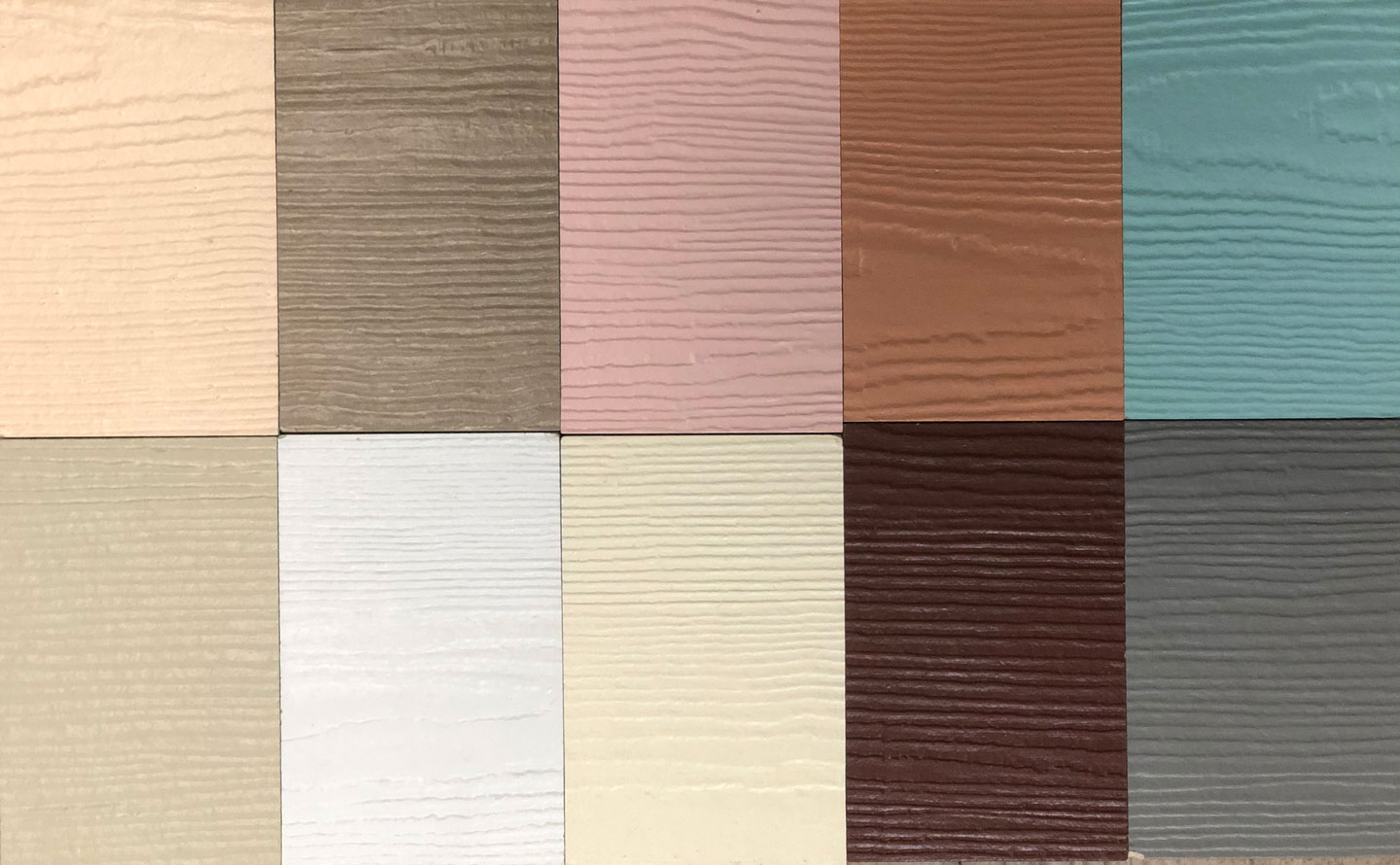
Vinyl Siding
Vinyl siding is a versatile choice that complements a range of architectural styles, including contemporary, colonial, and Cape Cod homes. Due to its durability, low maintenance requirements, and wide range of stylistic choices available, vinyl siding is the second most commonly used material in home exterior siding, with 26% of homes using it.
Pros:
- Affordable: Vinyl siding is a cost-effective option for homeowners on a budget.
- Low Maintenance: It doesn’t require painting and can be easily cleaned with just soap and water.
- Durability: Resistant to rot, insects, and moisture, it can withstand various climates.
- Variety: Available in numerous colors and styles, including faux wood finishes.
Cons:
- Limited Aesthetic Authenticity: While versatile, it often can’t capture the authentic look of wood or other natural materials.
- Vulnerable to Extreme Heat: Sources of heat, including nearby grills and even sunlight reflecting from nearby windows can cause vinyl to bubble and warp.
- Relatively Short Life: Vinyl siding only looks its best for the first 10 years of its life, after which time it is common for it to begin to fade and crack.
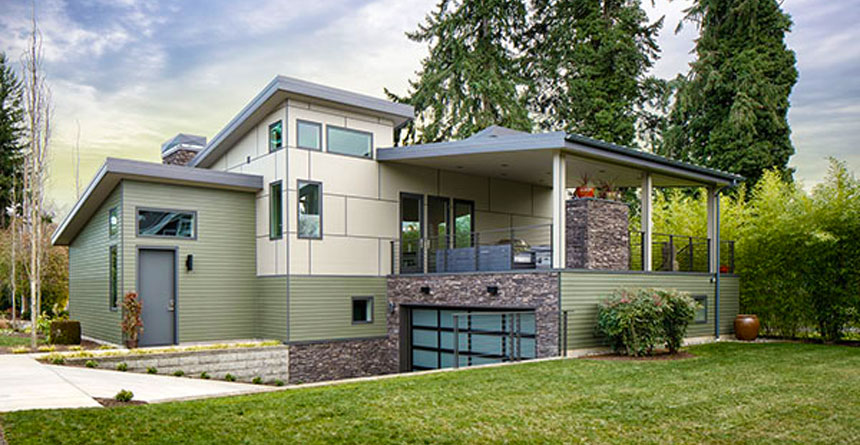
Wood Siding
Wood siding offers a classic and timeless appeal that enhances the architectural styles of traditional, rustic, and cottage-style homes. Wood comes in a wide variety of styles, ranging from board and batten to lap siding or even rustic log cabins.
While it was once quite common for siding to be made of wood, today wood siding is being used less often due to its demanding maintenance requirements and high cost.
Pros:
- Aesthetic Authenticity: There is a reason that other types of siding try to emulate the look of wood! It’s a timeless classic and incredibly versatile.
- Customizable: Homeowners can stain or paint wood siding in a variety of colors to match their preferences.
- Environmentally Friendly: Sustainably sourced wood is an eco-friendly choice.
Cons:
- Maintenance Intensive: Wood siding requires regular maintenance, including staining or painting and protection against pests and rot.
- Cost: Initial costs are often higher than many other siding materials.
- Vulnerable to Moisture and Pests: Wood can warp, rot, decay, or become infested with wood-destroying insects like termites if not properly maintained.
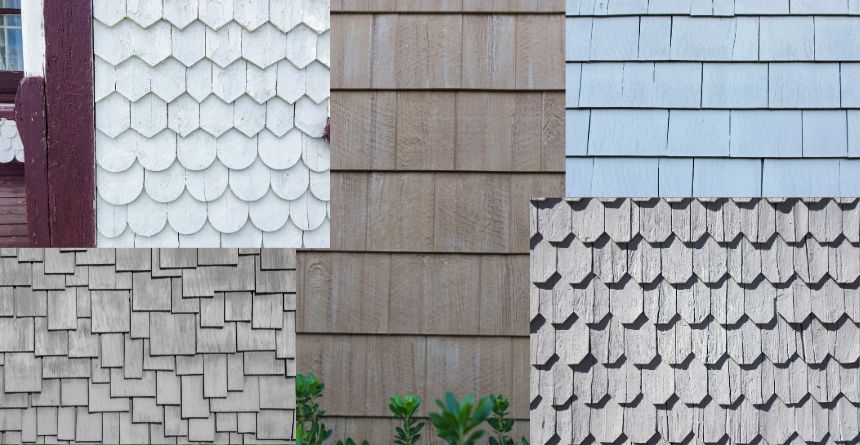
Cedar Shake & Cedar Shingle Siding
Cedar shake siding is known for its natural beauty and durability. These wooden shingles are a popular choice for Cape Cod and Craftsman style homes. Cedar naturally contains oils which act as preservatives, making it more resistant to decay and insects than most other types of wood.
Pros:
- Natural Beauty: Cedar siding boasts a warm, reddish-brown hue and distinctive grain patterns, enhancing the curb appeal of homes.
- Decay Resistance: Cedar contains natural oils that deter decay and insect infestations.
- Aromatic Fragrance: Cedar has a pleasant, natural aroma that adds to its charm.
- Dimensional Stability: It is less prone to warping and twisting compared to other wood species.
Cons:
- Maintenance Required: Like other wood siding types, cedar requires regular maintenance, including staining or sealing.
- Cost: Cedar shingle siding can be more expensive upfront than some other options.
- Limited Color Options: While cedar’s natural color is appealing, it offers fewer color choices than materials like vinyl or fiber-cement.
Wait, what’s the difference between shake and shingle?
Shingles are typically machine-cut and have a smooth, uniform appearance. This lets them offer a sleeker look, more suitable for formal architectural styles. Shakes on the other hand, are either hand-split or rough-cut, giving them a more textured, rustic look. They are generally thicker than shingles, which can increase both their price and their lifespan.
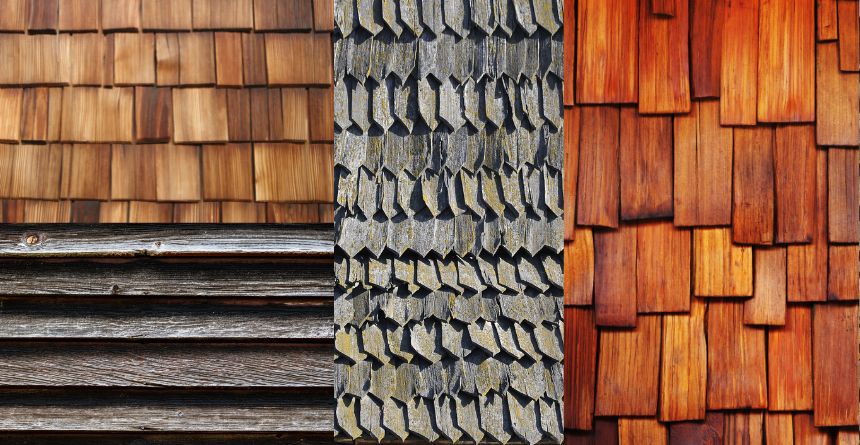
Engineered Wood Siding
Engineered wood siding is a modern alternative to traditional wood siding. Just like wood, it is incredibly versatile and complements various architectural styles, including contemporary, colonial, and ranch homes. Engineered wood siding is made by compressing wood fibers, resins, and adhesives, resulting in a durable and cost-effective siding material.
Pros:
- Cost-Effective: Engineered wood siding offers the look of real wood at a more affordable price.
- Low Maintenance: It typically requires less maintenance than natural wood and doesn’t need frequent painting or sealing.
- Durability: Engineered wood is designed to resist rot, termites, and moisture.
Cons:
- Aesthetic Variation: While it mimics the appearance of wood, the woodgrain is printed onto the surface and some homeowners may prefer the look of natural wood siding.
- Uncertain Lifespan: Engineered wood products are relatively new and some early varieties suffered from premature failure.
- Environmental Concerns: Some products may contain adhesives and resins that raise environmental concerns.
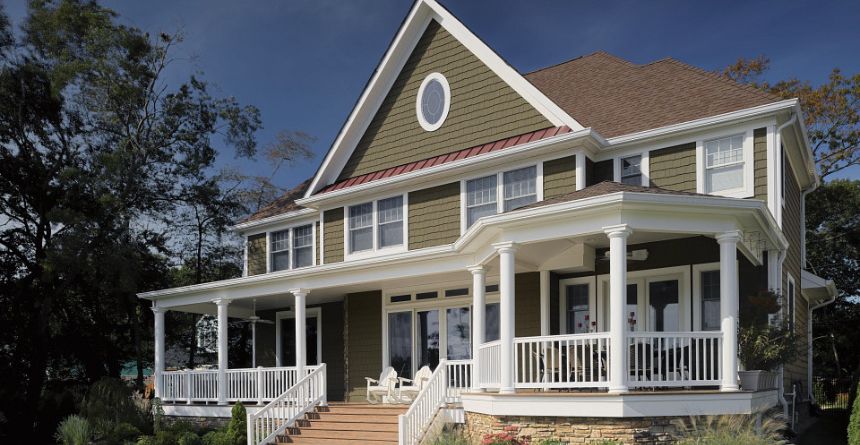
Brick Siding
Brick siding is a timeless and durable choice that complements a wide range of architectural styles, including colonial, Georgian, and Mediterranean homes. Unlike many other siding materials, brick is made from fired clay or shale, and it’s known for its classic and enduring appearance. Brick siding is one of the most durable types of siding in existence and there are brick structures which are many hundreds of years old.
While retrofitting brick siding is impractical – brick veneers are an option. These are essentially thin tiles of brick which are adhered to a home’s exterior.
Pros:
- Timeless Appeal: Brick siding offers a classic and elegant look that outlasts architectural trends.
- Durability: Bricks are highly resistant to weather, insects, and decay, and they can last for generations.
- Low Maintenance: Brick requires minimal maintenance and doesn’t need painting or staining.
- Fire Resistance: Brick is inherently fire-resistant, adding an extra layer of safety to homes.
Cons:
- Cost: Brick siding can have a higher initial cost compared to other materials.
- Limited Insulation: While bricks provide some insulation, they may not be as energy-efficient as modern insulated siding materials.
- Installation Complexity: Installing brick siding or brick veneers is labor-intensive and time-consuming.
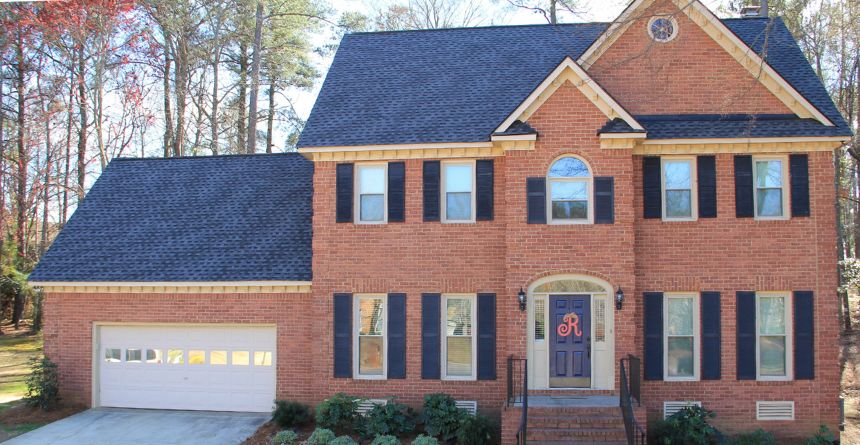
Fiber-Cement Siding
Fiber-cement siding, notably James Hardie fiber-cement products, is a modern and versatile siding material that complements various architectural styles, including contemporary, craftsman, and colonial homes. Hardie Board is made from a blend of Portland cement, sand, and cellulose fibers, resulting in a durable and weather-resistant siding option.
Pros:
- Durability: James Hardie fiber-cement siding is renowned for its durability, with resistance to rot, insects, and extreme weather conditions.
- Low Maintenance: It requires next to no maintenance and is highly resistant to fading and peeling.
- Aesthetic Variety: It comes in a wide range of textures and colors, allowing homeowners to achieve different looks.
- Fire Resistance: Fiber-cement siding is non-combustible and adds an extra layer of fire protection to homes. In many cases home insurance policies offer reduced rates for homes with fiber-cement exteriors.
Cons:
- Upfront Cost: The installation cost of James Hardie fiber-cement siding can be higher than some other siding materials.
- However, the long-term cost is often the same or lower due to lower maintenance costs and longer lifespan.
- Professional Installation: Proper installation is crucial, and should be performed by installers with experience working with the material.
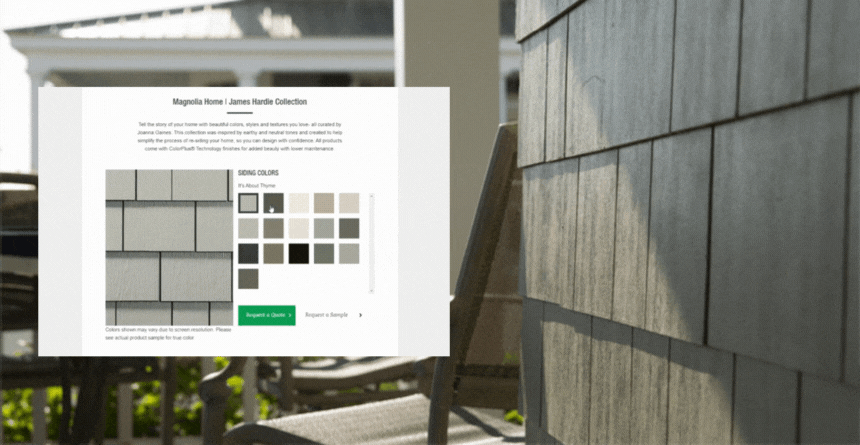
Stone Veneer Siding
Stone veneer siding is a visually striking choice that adds a sense of luxury and timeless beauty to various architectural styles, such as rustic, Mediterranean, and modern homes. It offers the aesthetic appeal of natural stone without the weight and cost associated with full stone construction. Less commonly used for entire homes, it can make for elegant accents around entryways.
Pros:
- Aesthetic Elegance: Stone veneer siding imparts a luxurious and distinctive appearance to homes.
- Durability: Stone veneer is resistant to weather, insects, and decay, ensuring a long-lasting and low-maintenance siding option.
- Versatility: It is available in various stone types, colors, and patterns to suit different design preferences.
Cons:
- Cost: Stone veneer siding can be more expensive than some other siding materials, both in terms of materials and installation.
- Installation Expertise: Proper installation is critical, and it requires skilled professionals.
- Limited Insulation: Stone veneer provides minimal insulation compared to some other siding materials.
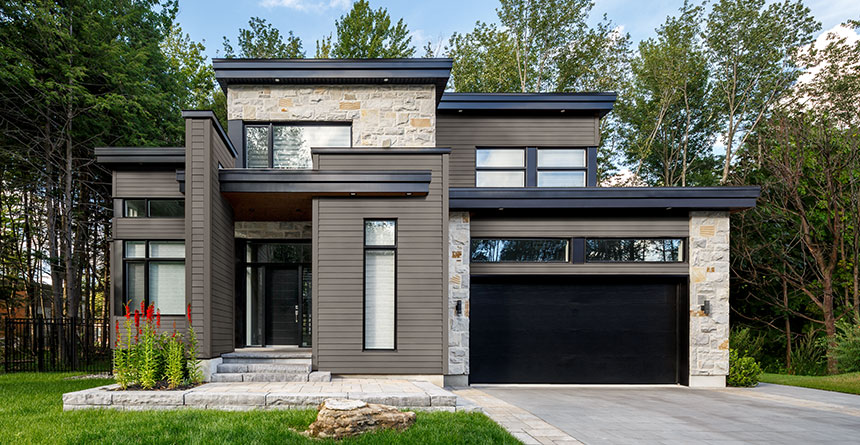
Stucco Siding
Stucco is a versatile and distinctive choice that complements architectural styles such as Mediterranean, Spanish Colonial, and Southwestern homes. It is a siding material made from a mixture of cement, sand, and water, creating a textured and durable surface that can be tinted to various colors.
Pros:
- Unique Texture: Stucco siding provides a unique and textured finish that adds character to homes.
- Durability: It is highly durable, resistant to fire, insects, and weather.
- Low Maintenance: Stucco requires minimal maintenance and can last for decades.
- Energy Efficiency: Stucco provides natural insulation, helping with energy efficiency.
Cons:
- Installation Complexity: Proper installation of stucco can be complex and requires professional expertise.
- Durability: Over time, stucco can develop small cracks, which can be repaired but require attention. This problem can be exacerbated by humid climates which experience freezing temperatures in the winter.
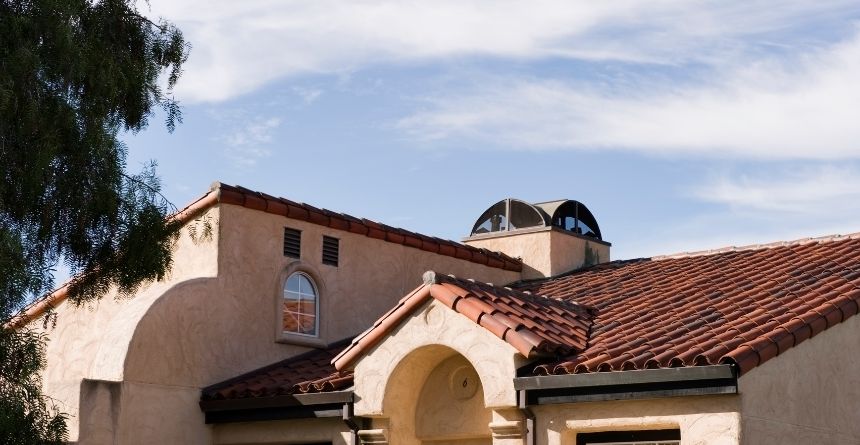
Metal Siding
Metal siding is a modern and durable choice that complements architectural styles with a contemporary or industrial aesthetic, such as modern, minimalist, and industrial-style homes. It is typically made from aluminum, steel, or corrugated metal sheets, offering a sleek appearance.
Pros:
- Durability: Metal siding is exceptionally durable, resistant to weather, insects, and decay.
- Low Maintenance: It requires minimal maintenance and doesn’t need painting or staining.
- Fire Resistance: Metal siding is non-combustible, adding an extra layer of fire protection to homes.
Cons:
- Limited Aesthetic Compatibility: Metal siding may not suit traditional or historic architectural styles.
- Cost: While it can be cost-effective in the long run, the upfront installation cost is often quite high.
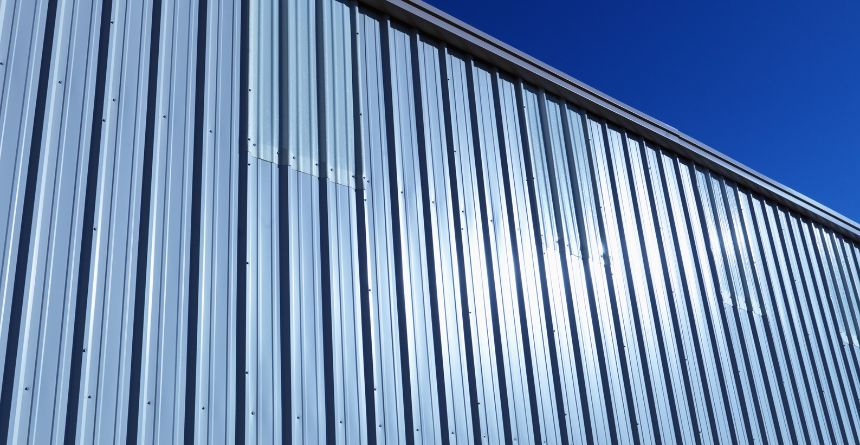
Factors to Consider When Choosing Siding
Climate & Weather Conditions
Technically, any siding can be installed in any climate. However, the harsh reality is that some types of siding will perform better than others, and the best siding option for your home is one that can handle the weather conditions of your area.
If you like the look of a siding like stucco, but your area has high humidity and winters with freezing temperatures, then you may want to consider alternatives which offer the same appearance. James Hardie’s Architectural Panels closely match the look of stucco, but are far more resistant to cracking, even in harsh weather conditions.
Your Home’s Architectural Style
Style is a personal choice, but unusual combinations of siding and housing style can cause some raised eyebrows. Thinking about minimalist aluminum siding on your craftsman style home? You might like it – but when you go to sell your home in the future you may find that buyers don’t share your opinions!
Similarly, your choice of siding color can serve to enhance your home’s style. Need some help choosing the right color? Check out our blog on color ideas for different styles of home.
Budget
It would be lovely to say that price doesn’t matter, but we simply don’t live in such a world!
Oftentimes our siding choices are at least partially dictated by financial realities, which goes a long way towards explaining the popularity of low cost options like vinyl siding.
However, we urge caution on assuming that a low upfront siding cost is the same as a low cost of ownership.
Oftentimes, budget siding products have significantly shorter lifespans than their slightly more premium counterparts, and ultimately cost homeowners more in the long run.
We have an entire article examining the total cost of ownership of vinyl siding versus James Hardie siding, and the results may surprise you!
Maintenance Level
Homes require maintenance in order to stay looking their best – but how much upkeep is required has a lot to do with the choices you make!
Some home siding options, like natural wood, require frequent painting, sealing, or staining. These protective treatments need to happen regularly, or else you risk serious problems like pests, mildew, mold, cracking, and warping. Other types of siding, like Hardie Board, brick, and metal siding are as close to maintenance free as possible. The occasional cleaning will keep these sidings looking great for decades!
Even if you are into DIY home improvement projects, the convenience of low-maintenance house siding is hard to argue with. Keep in mind that if your new siding comes with a warranty, you may be required to prove that regular maintenance was performed in order to make a warranty claim. Be sure to read the fine print of warranties to avoid any unpleasant surprises.
Choosing the Right Siding
While there might not be a ‘best’ siding, there are sidings that are a better choice for your home. We recommend picking a long lasting, low-maintenance siding that matches your home’s architectural style. While some budget choices may look like a good idea upfront, keep in mind that these lower cost options usually end up costing you more over time.
For us, we believe that James Hardie fiber-cement siding is one of the most versatile sidings on the market, with plenty of design options, incredible longevity, all while requiring next to no maintenance! No matter what material you choose, be sure to have your siding installed by a reputable, local installer.
